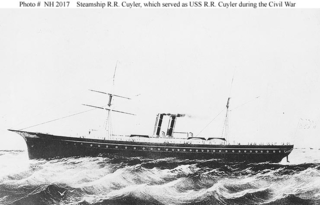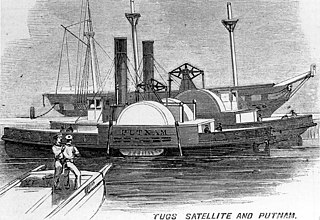USS New London was a screw steamer of the Union Navy during the American Civil War. She was outfitted with a Parrott rifle and 32-pounders, and was assigned as a gunboat in the Union blockade of the Confederate States of America.

CSS Oregon was a wooden sidewheel steamer that served as a gunboat in the Confederate States Army during the American Civil War. Built in 1846 for the Mobile Mail Line, she transported mail between New Orleans, Louisiana, and Mobile, Alabama, before the war. In 1861, she was seized by the Governor of Louisiana, Thomas Overton Moore, and served as a blockade runner before being selected for use by the Confederate Army. After transferring men and supplies to Ship Island, she was formally converted into a gunboat and armed with four cannon. Remaining behind on Lake Pontchartrain when many Confederate warships were transferred up the Mississippi River, Oregon served in the Mississippi Sound and Pass Christian areas. She took part in several minor actions involving USS New London, two of which resulted in the Confederates moving into shallow water to avoid close-range action, and the third ending when the Confederate ships abandoned the Pass Christian area. In April 1862, Union pressure confined her and other Confederate ships to Lake Pontchartrain. Later that month, with Union forces closing in on New Orleans, Oregon was sunk as a blockship. Her wreck was removed and destroyed in the early 1870s.
William W. Kennison (1825–1893) was an officer in the United States Navy during the American Civil War.

USS Sciota was a Unadilla-class gunboat built on behalf of the United States Navy for service during the Civil War. She was outfitted as a gunboat, with both a 20-pounder rifle for horizontal firing, and two howitzers for shore bombardment, and assigned to the Union blockade of the waterways of the Confederate States of America.

USS R. R. Cuyler was a steamer in the United States Navy during the American Civil War. She was outfitted by the Union Navy as a gunboat and was assigned to the Union blockade of the Confederate States of America.

USS Albatross was a screw steamer rigged as a three-masted schooner acquired by the Union Navy during the beginning of the American Civil War. She was outfitted as a gunboat with heavy guns and used in the Union blockade of the waterways of the Confederate States of America.
USS Sam Houston was a small (66-ton) schooner captured by the Union Navy during the beginning of the American Civil War.

USS Sagamore was a Unadilla-class gunboat built on behalf of the United States Navy for service during the American Civil War. She was outfitted as a gunboat and assigned to the Union blockade of the Confederate States of America. Sagamore was very active during the war, and served the Union both as a patrol ship and a bombardment vessel.
USS Rachel Seaman was a wooden schooner purchased by the Union Navy during the American Civil War.
USS Itasca was a Unadilla-class gunboat built for the U.S. Navy during the American Civil War. She was used by the Navy to patrol navigable waterways of the Confederacy to prevent the South from trading with other countries.

USS Winona was a Unadilla-class gunboat built for service with the Union Navy during the American Civil War. Winona was heavily armed, with large guns for duels at sea, and 24-pounder howitzers for shore bombardment. Winona saw significant action in the Gulf of Mexico and in the waterways of the Mississippi River and was fortunate to return home safely after the war for decommissioning.

USS General Putnam – also known as the USS William G. Putnam – was acquired by the Union Navy during the first year of the American Civil War and outfitted as a gunboat and assigned to the Union blockade of the Confederate States of America. She also served as a tugboat and as a ship's tender when so required.
USS John Griffith was a mortar schooner acquired by the Union Navy during the American Civil War. She was used for various purposes, but, especially for bombardment because of her large 13-inch mortar and 12-pounder howitzers that could fire up and over tall defensive riverbanks.
USS Western World was a ship acquired by the Union Navy during the American Civil War. She was used by the Navy to patrol navigable waterways of the Confederacy to prevent the South from trading with other countries.
The USS Beauregard began the war as a Confederate privateer. The Union Navy acquired the schooner from the prize court and outfitted the vessel for blockade duty.
USS William G. Anderson was a barque used by the Union Navy during the American Civil War. She was assigned by the Navy to patrol navigable waterways of the Confederacy to prevent the South from trading with other countries.

USS Calhoun was a captured Confederate steamer and blockade runner acquired by the Union Navy from the prize court during the American Civil War.
USS Matthew Vassar was a schooner purchased by the Union Navy during the American Civil War. She was used by the Union Navy primarily as a mortar gunboat, but also as a gunboat stationed off Confederate ports to prevent their trading with foreign countries.

USS Tahoma was a Unadilla-class gunboat built by order of the United States Navy for service during the American Civil War.
USS Wyandotte, originally USS Western Port, was a steamer acquired by the Navy as a gunboat for the Paraguay expedition in 1858. When the crisis of the American Civil War occurred, she operated in support of the Union Navy blockade of Confederate waterways.








